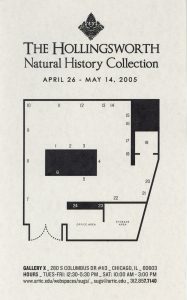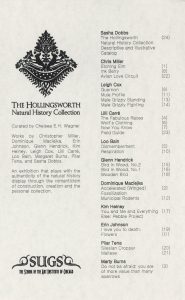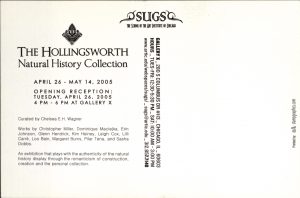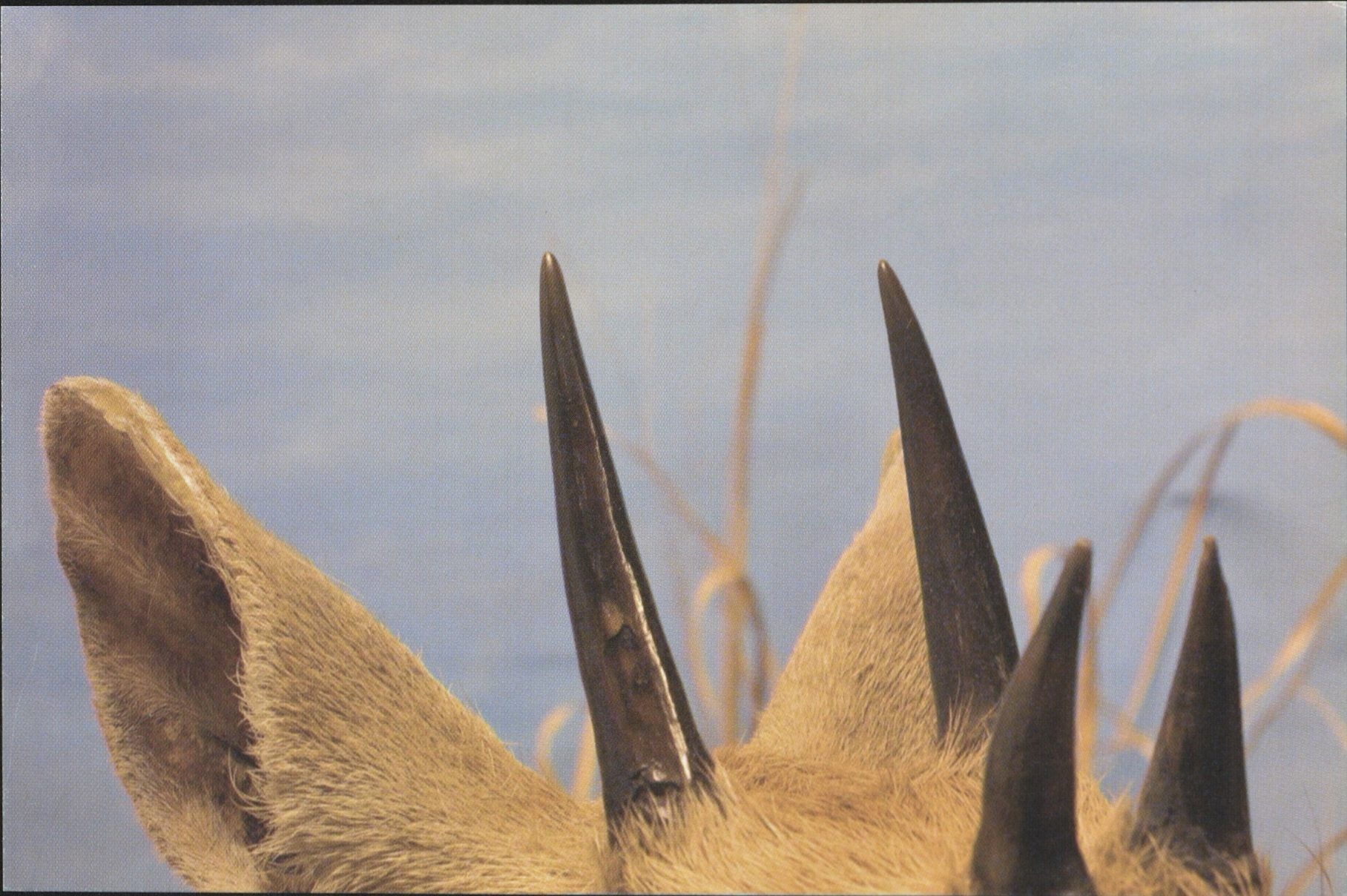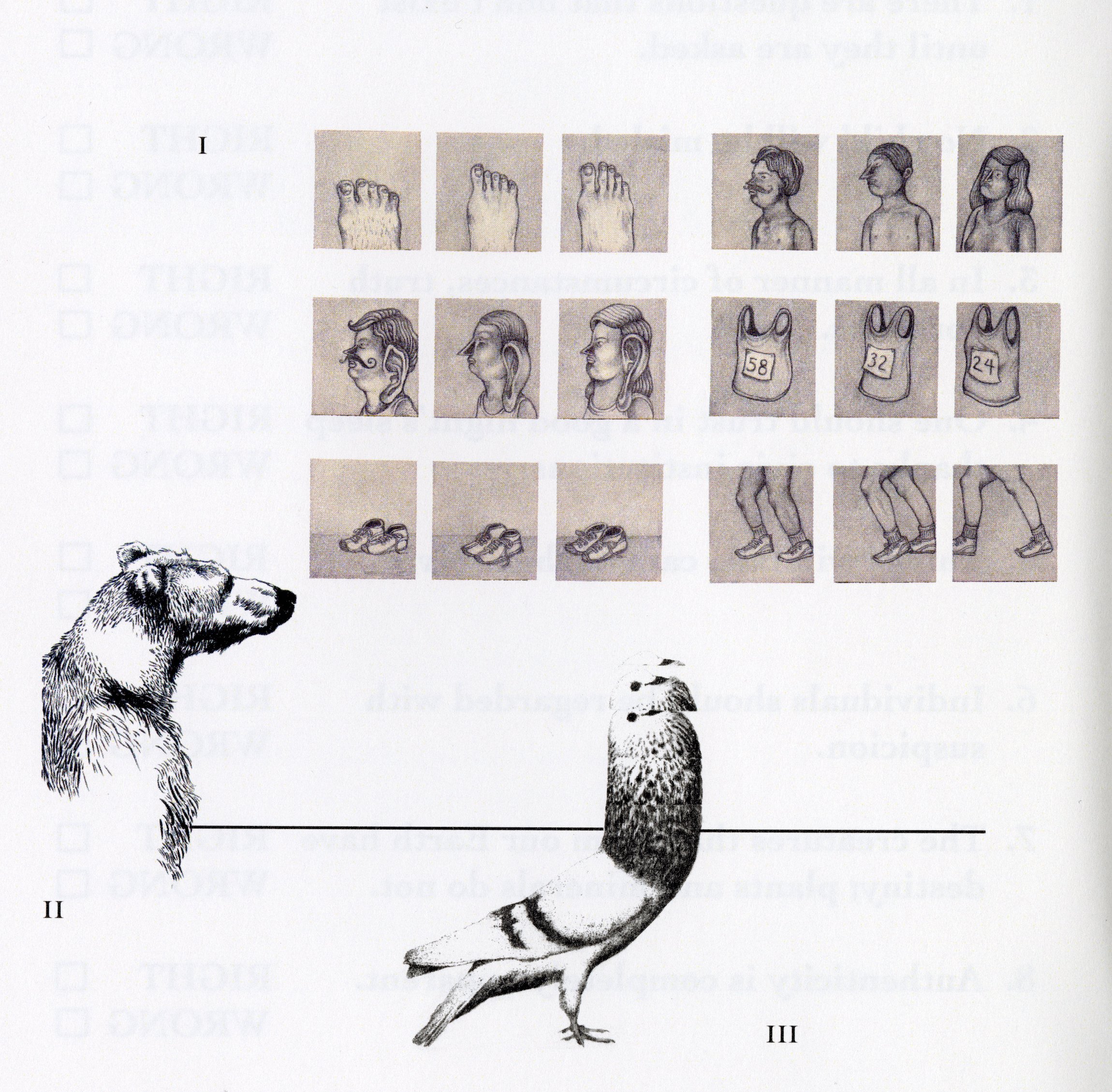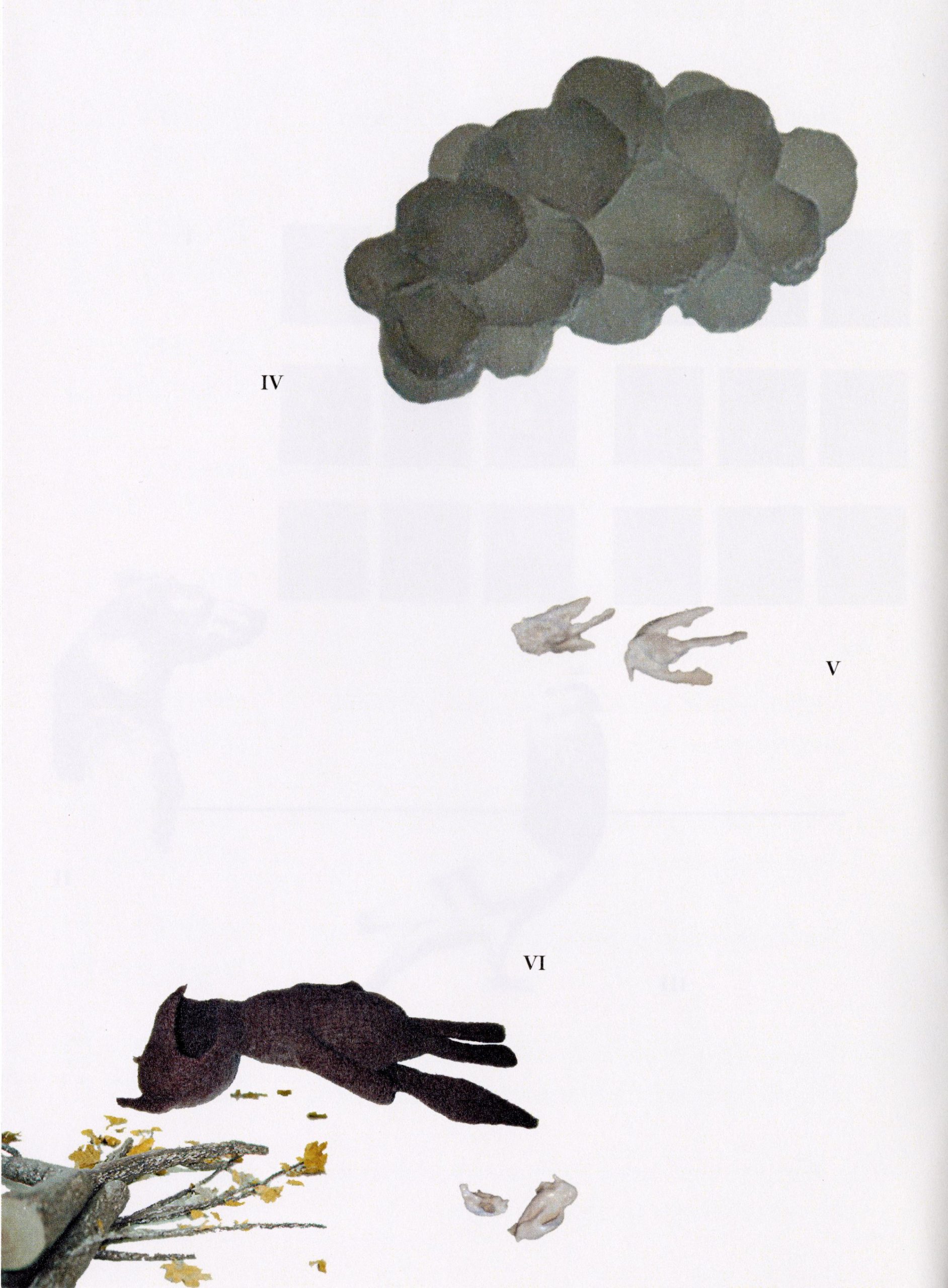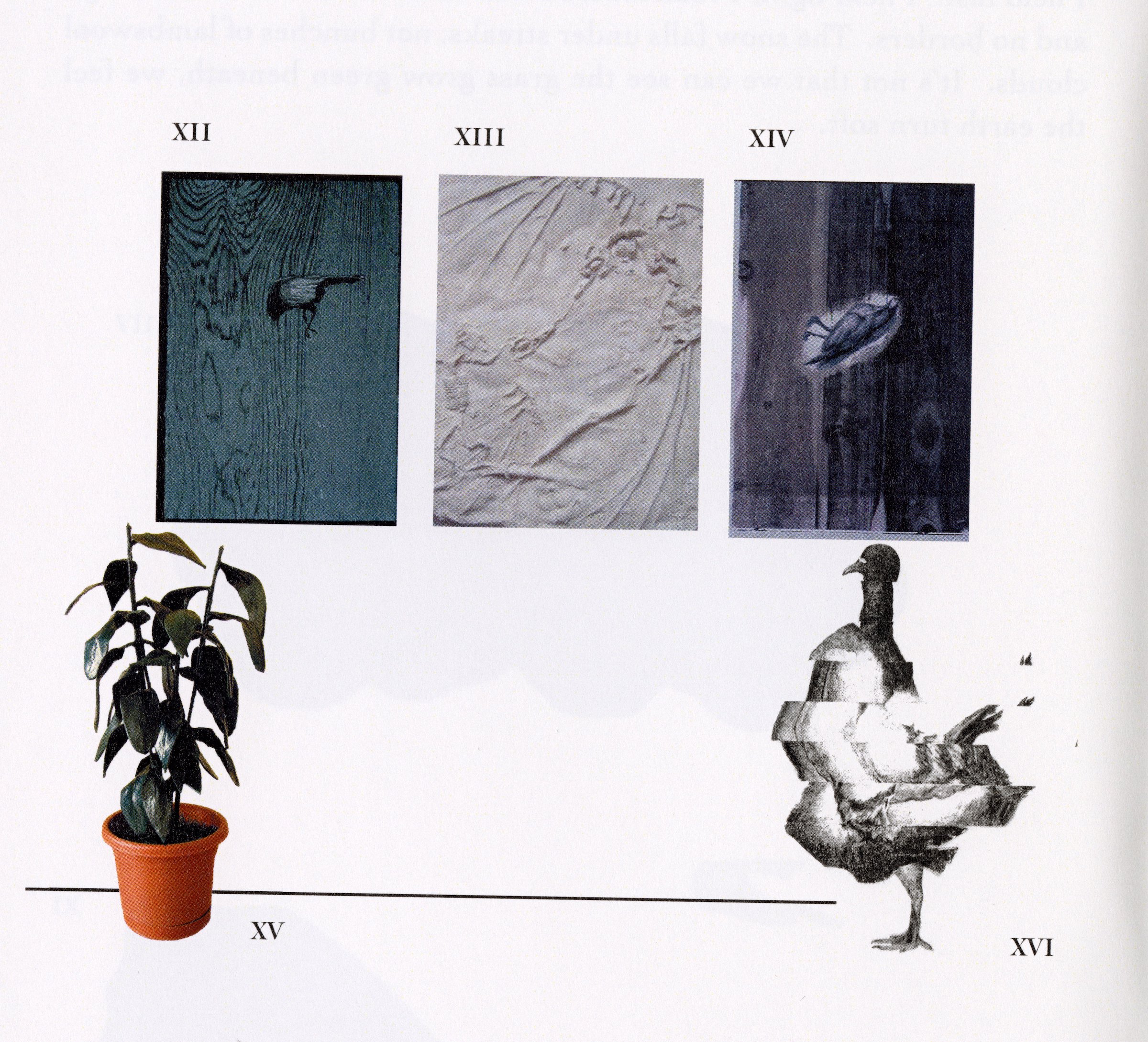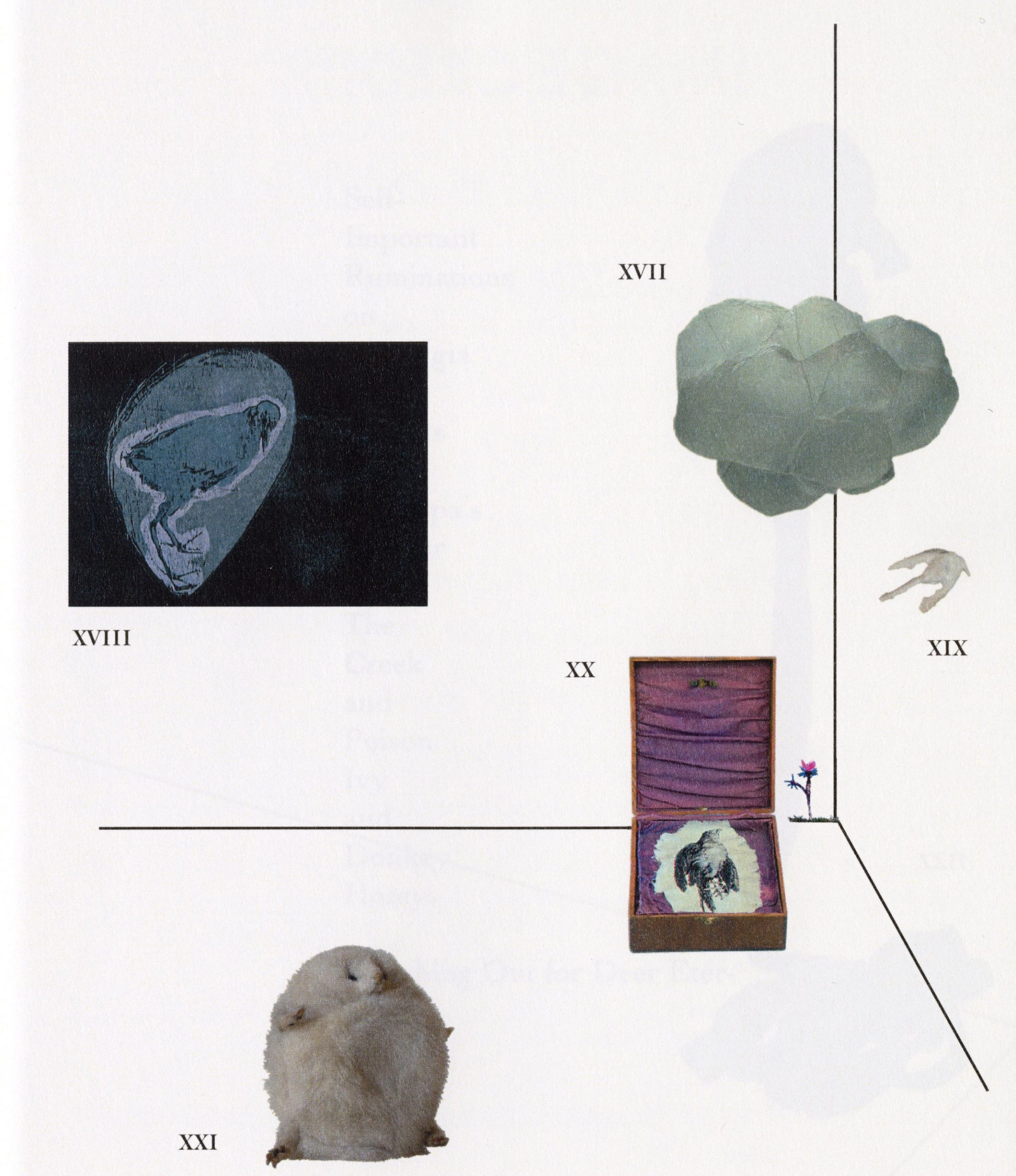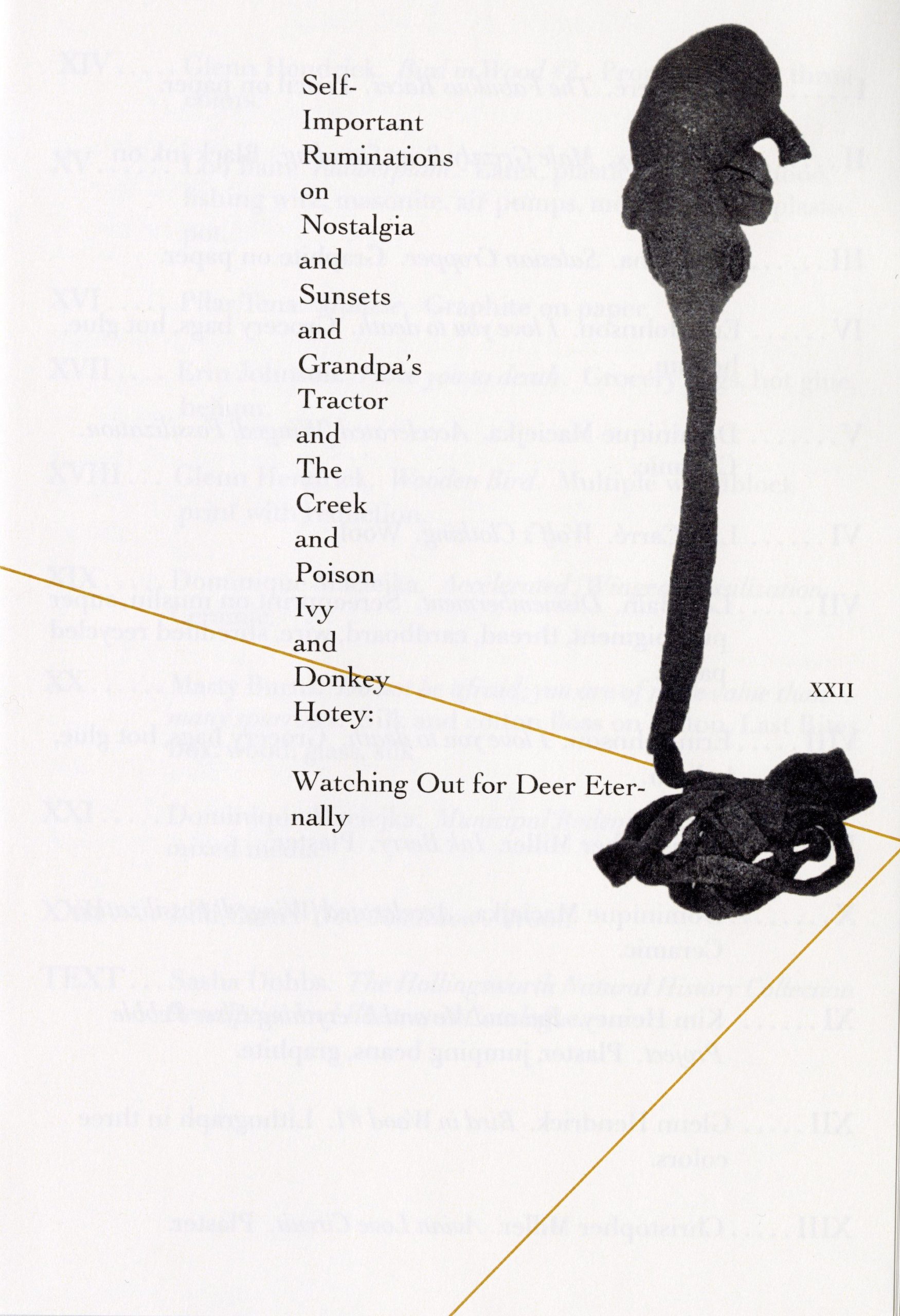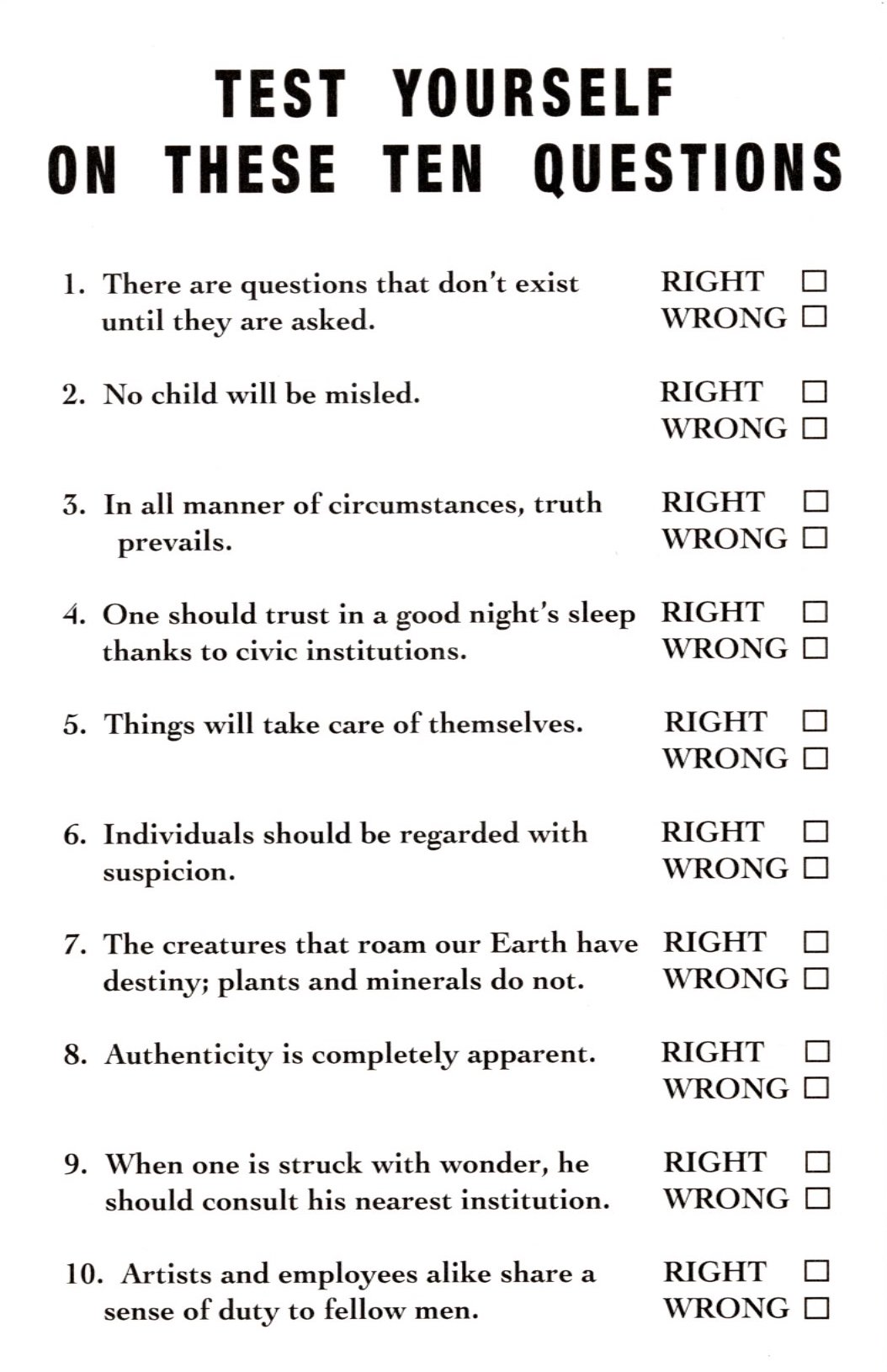The Hollingsworth Natural History Collection
2005
April 26 – May 14
Gallery X
Organizer
Chelsea E.H. Wagner
Contributing Artists
Christopher Miller, Dominique Maciejka, Erin Johnson, Glenn Hendrick, Kim Heiney, Leigh Cox, Lilli Carre, Loo Bain, Margaret Burns, Pilar Tena, Sasha Dobbs
Exhibition Statement as Preserved in the SUGS/SITE Archives:
An exhibition that plays with the authenticity of the natural history display through the romanticism of construction, creation and the personal collection. // The gallery space will be transformed into a museum houseing the collection of the esteemed artist-muralist Ernest B. Hollingsworth Having graciously loaded his work for a travelling exhibition, he has agreed to install his collection adjacent to the Art Institute in hopes of inspiring a new generation of artists to participate in his exploration of the natural. Inspired by natural history museums’ taxidermy and plant displays, the Museum of Jurassic Technology (and their authentically displayed, human-constructed exhibits), the La Brea tar pits (and their imagined action displays of no longer existing animals), and personal collections of artifacts, we are trying to construct a miniature museum-like exhibition space that replicates a personal natural history musuem in which student work dealing with constructions of nature are displayed under the guise of authenticity. Organizing the nature exhibition in an attempt the mythology and re-representations that are placing the ‘real’ in the understanding of nature. By contextualizing these works in a museum-like exhibition space through the appropriation of museum display devices such as dim lighting, Plexiglas vitrines, fossiles inlayed in the wall, and educational wall texts, we are elevating ‘artistic’ representation through the usage of pedagogical, institutional display techniques. We are creating a parallel to the equally constructed displays of a meuseum and also challenging the authenticity of thses displays by neutralizing the difference between authoritative taxidermy installations and a felted wolf or plastic cloud.
Programs
April 26, 4:00 – 6:00 PM
Gallery X
Exhibition Material
Descriptive and Illustrated Catalogue
The Hollingsworth Natural History Collection
Marty Burns
Do not be afraid; you are of more value than many sparrows.
Dear Sir,
I am dissatisfied. It has been six years since I scattered my father’s ashes in the Arizona sand: I have continued to kill sparrows but you have yet to return him.
Marty Burns
Lilli Carre
Artifacts of Allegory; The Fabulous Races
The Fabukous Races
The drawings of the Fabulous Races address the dubious nature of history through a dubious history of nature. They are based on the invention of specific monstrous races and animals, a western conception of the marvels of India given the umbrella term of “the Fabulous Races”. Originally concocted in Greece as early as the 4th century B.C.E., these characters have endured for two thousand years, clossoming in the period of the Romance of Alexander the Great, Reiterated in the Middle Ages, etc.
Some examples of Fabulous Races are as follows:
People with ears large enough to sleep in
People with the heads and necks of Cranes
People with one large foot with which to shade themselves from the sun
People without mouths who live of off the smell of roasted flesh and the aroma of flowers and fruit.
The Fabulous Races were manifested in cartography and geography, cosmography, and natural history. These charactes were not discarded as more was learned about the East, but continued to appear as recently as the 17th century. I’m interested in the persistence of these invented races and their presentation within institutions that generally tout their own legitimacy. In the drawings, I use this malleable history, as a jumping-off point to stray further from fact through a pictorial misinterpretation of the history of the Fabulous Races, presented in a museum context.
Artifacts of Allegory
In these pieces, I investigate history as storytelling, and the tendency of histroical fact to be interwoven with morals and punch lines. Here in the Natural History Collection I present two animal husks, an elephant with an exaggerated trunk, stretched a but too long, and a wolf made of wool. These are based on explanatory stories, Rudyard Kipling’s “The Elephant’s Child” and Aesop’s “Wolf in Sheep’s Clothing,” respectively.
They may serve as some or all of the following:
They are costumes, reflecting the themes of subterfuge and cloaking that often pervade stories such as these.
They are hollow constructions.
They are artifacts of allegorical stories, physical carcasses of proposed explanations of both the natural world and human nature.
They are not genuine carcasses, as the careful observer will notice, but rather made of spun yarn, like any other story.
“‘Scuse me,’ said the Elephant’s Child most politey, ‘but have you seen such a thing as a Crocodile in these promiscous parts?'”
“‘Come hither, Little One,’ said the Crocodile, ‘for I am the Crocodile,’ and he wept crocodile-tears to show it was quite true.”- Ruyard Kipling
“…One day it found the skin of a sheep that had been flayed and thrown aside, so it put it on over its own pelt and strolled down among the sheep.”-Aesop
Leigh Cox
North American Bears
I have always been immersed in wildlife art. As a child, it was delivered to me in regular monthly doses in the form of a magazine called “Fur Fish Game” which my dad is the editor of. It touts itself as “The magazine for the practical outdoorsman.” The magazine featured an amazing piece of original art on the cover each month with some sort of animal looking quite majestic, and the pages were filled with photos and illustrations of deer, bears, raccoons, minks, etc. that were just begging to be drawn over again.
I started out at an early age tracing other peoples photos and drawings, and then as I got older started doing my own. In these three works I am trying to re-create the feeling in other people that I have always had for wildlife art, the challenge of accurately portraying an animal while at the same time showing the presence of the artists hand. Drawing or painting an animal gives it a life and personality that is not present in photographs for me. These pieces are the kind of work I would see as a child in my dad’s magazine and the various field guides he would bring home for me, which would lead me into hours of meticulous drawing at my kitchen table, and in turn have produced the work you see here.
Sasha Dobbs
The Hollingsworth Natural History Collection Catalogue
The function of this catalog is to act as a portable space in which the many tensions and folly of the collection may intertwine, react, and be archived. It is the result of another artist’s experience of viewing the Colection. It takes advantage of the authority granted to The Catalogue, using this platform to play out a different approach to documentation.
As one approaches this catalog, it would appear to be an official textual archive of the items in the Hollingsworth Collection. However, the pages contain experiential data rather than physical data. The catalog, too, is revealed to be an artiface.
Be removing the expected information one may normally use as an aid for seeing and understanding what is exhibited, viewers are left to decide where they stand. One may take the content of the catalog as a record of the show, or question its authority and finality as a document. This moment of disorientation is similar to that felt when viewing other pieces in the Collection, and reinforces, rather than dissipates, any opacity.
Viewers are encouraged to see the show through their own eyes, to embrace the absurdity presented and to confront the many contradictions and edges contained in the Hollingsworth Natural History Collection.
Kim Heiney
You Me and Everything Else
Pebble Project
Pebbles are taken from a site, then reinserted into the site as casts with Mexican jumping beans inside.
My hope is that pebbles with a pulse will puncture the closure we feel we’ve established with our valuating navigation systems. Using a real life source to apply a fictionalized lifespan to a form that has its own relaity as a nature object subverts the viewer’s understanding of what we think is alive, andhow we think they’re alive.
You Me and Everything Else Mission Statement
Traveling through an environment over time will inevitably lead to the development of a personal navigation system. This sytem determines which elements require what amount of attention, to maximize efficiency of both time and brain power. This navigation is especially neccessary in a city with an unnegotiable amount of elements. I fear that this valuation results in an editing process, that reduces the chance of noticing something unexpected, be it a surface, moment, person, etc.
I’m interested in the way this efficiency-based navigation has been translated in public transportation routes, with examples ranging from trains to sidewalks to grocery aisles. My work takes place in these sites, and acts by using the material and social properties specific to the sites. Because of this, each project is contextual in process and product. My method is to reconfigure the properties of an environment in order to draw attention to what’s already there. Using the elements of humor and surprise as an entry point, an open and non-confrontational mental and emotional space is provided for the viewer to reconsider what the site can be, and how it can work. The aim of my work is to be expansive rather than reductive. The emphasis is not in a reassessment, but on the act of re-assessing.
Glenn Hendrick
Bird in Wood #1; Bird in Wood #2; Wooden Bird
Collecting to me, replaces objects from the context of living, passing time, into a context removed from time. The history represented by a disinterred relic ends precisely wiht its disinterment, when active decay becomes static preservation. History is rought up flush with the present, an eternally maintained present. Biological specimens face stillness both in death and in the preservation of death, where they are held, kept, static markers in flowing time. Things have to hold still to be processed understood. Living is too quick to see, and dying disappears.
Erin Johnson
I love you to death.
Desire is a destructive force that meddles with good intentions in the most interesting way. Between wanting something and psessing something there is a large gap, and denying this gap is a source of incredible disappointment.
I was disappointed when I had my dead cat taxidermied. He was disappointed when he woke up to find ajar of dead fireflies by his bed. They were disappointed when the whales were sleeping at the zoo.
These clouds are an apology to those who have been unintentionally suffocated.
Dominique Maceijka
Accelerated [Winged] Fossilization; Municipal Rodent
I like to create work that plays with the boundaries of the tryth, myth and reality augmented through human interaction. By taxidermying creatures in a way that is also playful, I pose the question of whether the creature is a displayed trophy intended for adults or an elaborate child’s toy and what the difference between those really is. This question runs parallel to the question of the creatures’ authenticity as well. To what degree have I modified it and to what degree have humans modified today’s animals.
I began working with animal figures after working at an animal hospital and seeing animals’ lives extended through the use of modern day medicine. While wokring with many theater and film companies, my interest in mythical creatures grew. At the same time, I began being interested in the concept of stuffed animals. I began researching children’s toys, taxidermy, and playing with the boundaries between the two. I also research fossils, science and the interactions of nature and science. I work with ceramics and fur. I am reminded that these materials amy come from natural sources but my interaction with them already makes the into something new. I employ many special effects, mold making and puppetry making skills into my work. Incorporating mechanical elements and prosthetic elements became the element between science and nature that balances the reality of my pieces. I begin a piece by researching an experiment or mythical creture. The authenticityof either becomes the same to me.
My work allows the viewer to physically interact with the pieces. Their tactility and undeniable, often obnoxious presence, makes the creatures irresistible to the touch. This idea encourages viewers to reconsider the concept of an institutionalized art piece and consider her ntion of the line between a stuffed animal and taxidermy, as well as art work. To me, it is more important for the piece to be interactive and be enjoyed by the viewer, rather than convey any social commentary. My intent is simply to create an interesting play between nature, technology and the human modification of the two. it is strictly the viewer’s place to place ethical values upon these concepts.
Christopher Miller
Avian Love Circuit; Etching Elm; Ink Berry
These plasters were conceived while browsing through a book of fossils. In it I came across a picture of two prehistoric fish that appeared to have been preserved in the very moment that one was swallowing the other whole. The smaller fish’s head was discernible between the larger one’s ribs, but its tail still protruded from the predator’s mouth. Chance and time had scribbed down their imprint as a natural poem.
While only a few lines are “etched in stone”, these natural poems abound in the world we inhabit – they are blown across our sidewalks, framed in our windows, and displayed in other places don’t always inspire a second thought.
These plasters are my own petroglyphs. They are fantastic liberties taken with what is perhaps the oldest literary device and published in an artist’s material.
Pilar Tena
Maltese; Salesian Cropper
The breeding process used to create the fancy pigeon is based within the concentration of specific reoccurring genetic traits. Bone structure, color, markings, and feather growth, are all carefully considered and then repeated to achieve a certain aesthetic end. this refinement often leans towards absurd and unnatural results, skewing the ideals of beauty and form. No longer relying on the means of simple procreation, characteristics posessing curious and ornament become key.
